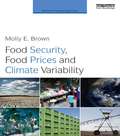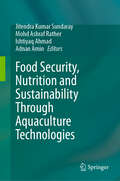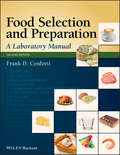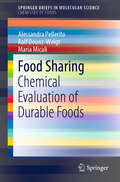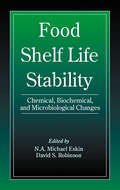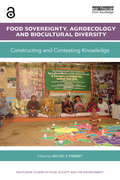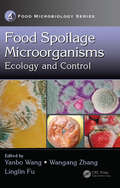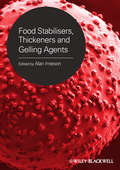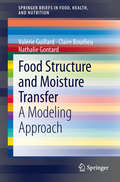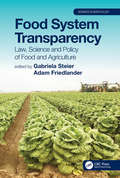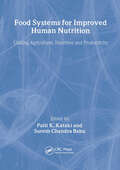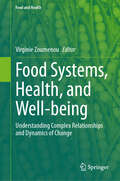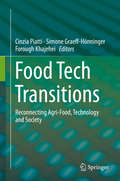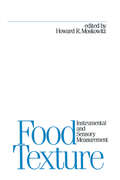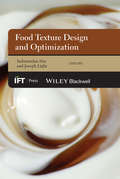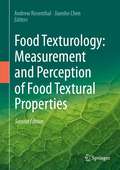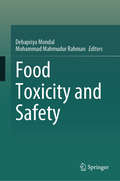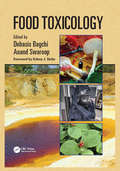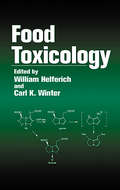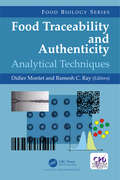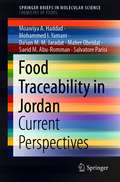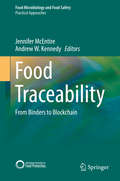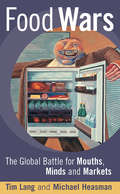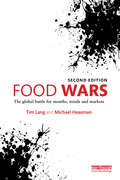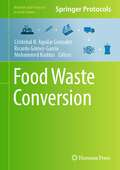- Table View
- List View
Food Security, Food Prices and Climate Variability (Earthscan Food and Agriculture)
by Molly E. BrownThe agriculture system is under pressure to increase production every year as global population expands and more people move from a diet mostly made up of grains, to one with more meat, dairy and processed foods. This book uses a decade of primary research to examine how weather and climate, as measured by variations in the growing season using satellite remote sensing, has affected agricultural production, food prices and access to food in food-insecure regions of the world. The author reviews environmental, economics and multidisciplinary research to describe the connection between global environmental change, changing weather conditions and local staple food price variability. The context of the analysis is the humanitarian aid community, using the guidance of the USAID Famine Early Warning Systems Network and the United Nation’s World Food Program in their response to food security crises. These organizations have worked over the past three decades to provide baseline information on food production through satellite remote sensing data and agricultural yield models, as well as assessments of food access through a food price database. These datasets are used to describe the connection, and to demonstrate the importance of these metrics in overall outcomes in food-insecure communities.
Food Security, Nutrition and Sustainability Through Aquaculture Technologies
by Jitendra Kumar Sundaray Mohd Ashraf Rather Adnan Amin Ishtiyaq AhmadAquaculture is the farming of aquatic organisms such as fish, crustaceans, mollusks and aquatic plants. It is a rapidly growing industry that plays a significant role in providing food security, improving nutrition and promoting sustainability. Food security is a major global concern, with millions of people around the world suffering from malnutrition and hunger. Food security, nutrition and sustainability are global challenges that need urgent attention to achieve a better and more sustainable future. Aquaculture technologies can help to address this problem by increasing the availability and accessibility of fish and other aquatic foods, providing a source of protein-rich food, improving nutrition, enhancing sustainability, generating income and improving food safety. In addition, aquaculture technologies play an important role in promoting nutrition. Fish and other aquatic foods are a good source of essential nutrients that are important for human health, including omega-3 fatty acids, vitamin D and minerals like iron and zinc. By increasing access to these foods, aquaculture can help to improve nutrition and reduce the incidence of diet-related diseases. Fish and shellfish are rich in omega-3 fatty acids, which have been linked to improved heart health, brain function and other health benefits. By incorporating fish and shellfish into their diets, people can improve their overall nutritional intake and reduce the risk of chronic diseases. Food Security, Nutrition and Sustainability Through Aquaculture Technologies shines a light on how aquaculture technologies contribute to sustainability by providing a more efficient and environmentally friendly way of producing food. Compared to traditional fishing practices, aquaculture can reduce pressure on wild fish populations and minimize the negative impact of fishing on marine ecosystems. Additionally, advances in aquaculture technology have led to the development of more sustainable and efficient production systems, including recirculating aquaculture systems and integrated multi-trophic aquaculture. As the global population continues to grow, demand for protein-rich foods like fish is increasing. Aquaculture provides a sustainable way to meet this demand, as it can produce more protein per unit of feed than traditional livestock farming. This book discusses aquaculture practiced in areas where traditional agriculture is not feasible, such as regions that are unsuitable for crop production. In addition to providing a source of protein, aquaculture can also improve nutrition. Aquaculture can be practiced in a sustainable manner, with minimal impact on the environment. Unlike traditional fishing, which can deplete wild fish populations and damage marine ecosystems, aquaculture allows for the controlled cultivation of fish and other aquatic organisms. Properly managed aquaculture operations can also minimize waste and pollution and caneven contribute to ecosystem restoration by providing habitat for marine species. This book includes chapters on various aspects of aquaculture technologies that address a range of important global challenges including food security, nutrition and sustainability and are likely to play an increasingly important role in meeting the world's growing demand for food.
Food Selection and Preparation: A Laboratory Manual
by Frank D. ConfortiKnowledge, skill, and art are the three words to remember when working with foods. They are also the focus of the second edition of Food Selection and Preparation: A Laboratory Manual, which guides students through the fundamentals and basic principles of food preparation, from the recipe to the table, from the raw ingredients to the final product. This manual equips students with a working knowledge of the nature of ingredients and how they function in particular foods. A wide range of exercises--addressing topics from food preservation to frozen desserts, measuring techniques to fats and emulsions, fruit selection to egg cookery, breads and pastry to meat and poultry--guide students through standard recipes, with clear and complete directions for handling ingredients and cooking foods. Throughout, vocabularies introduce technical words essential to understanding food products and preparation. Questions to test students' knowledge follow each exercise. The text also includes discussion of laboratory procedures, sanitation in the kitchen, emergency substitutions, identification of meat cuts, the safe storage of food, and the care and cleaning of small appliances. New to this edition are over 50 additional recipes, which reflect the many tastes that influence today's palate. All recipes have been reviewed and updated to ensure healthful and nutritious food preparation, as well as product quality and performance. Students and instructors alike will find the new and improved recipes and updated nutritional and food facts of Food Selection and Preparation, Second Edition a truly satisfying full course.
Food Sharing: Chemical Evaluation of Durable Foods (SpringerBriefs in Molecular Science)
by Maria Micali Alessandra Pellerito Ralf Dounz-WeigtThis book presents the concept of food sharing from a European perspective, and provides a concise analysis of its safety implications and the chemical properties of recovered foods.In our modern world, 33% of the total food produced is lost each year, with serious economic, environmental and social consequences. Food worth approximately 1 trillion USD is wasted per year, and it is estimated that this wasted food could feed more than 3.4 billion people. Considering that 1/10 of the global population still does not have enough money for basic needs, and in view of the impact of consumer behaviour, food retailers and industry in food waste, food sharing appears to be an attractive solution, and several communities have recently been created with the main goal of saving food and giving it to those in need. Despite the positive impact of food sharing, it also raises concerns since recovered foods are subject to spoilage, decay and irreversible chemical-physical transformations.In this book, the authors explore the current situation and the regulatory definition of food sharing in various European countries, presenting the German experience in the city of Magdeburg, where food-sharing networks have been implemented. They also discuss the chemical and safety evaluations of durable foods, and provide a simulation of food waste by comparing a food product with the same food produced with re-worked and still edible raw materials (recovered foods).
Food Shelf Life Stability: Chemical, Biochemical, and Microbiological Changes (Contemporary Food Science)
by N .A. Michael Eskin David S. RobinsonFood Shelf Life Stability provides a unique approach to understanding this critical subject by examining physical, chemical, and biochemical factors affecting food quality. The first section emphasizes the effects that water activity, glass transition, and plasticization have on temperature, water content, and time-dependant phenomena affecting
Food Sovereignty, Agroecology and Biocultural Diversity: Constructing and contesting knowledge (Routledge Studies in Food, Society and the Environment)
by Michel. P. PimbertContestations over knowledge – and who controls its production – are a key focus of social movements and other actors that promote food sovereignty, agroecology and biocultural diversity. This book critically examines the kinds of knowledge and ways of knowing needed for food sovereignty, agroecology and biocultural diversity. ‘Food sovereignty’ is understood here as a transformative process that seeks to recreate the democratic realm and regenerate a diversity of autonomous food systems based on agroecology, biocultural diversity, equity, social justice and ecological sustainability. It is shown that alternatives to the current model of development require radically different knowledges and epistemologies from those on offer today in mainstream institutions (including universities, policy think tanks and donor organizations). To achieve food sovereignty, agroecology and biocultural diversity, there is a need to re-imagine and construct knowledge for diversity, decentralisation, dynamic adaptation and democracy. The authors critically explore the changes in organizations, research paradigms and professional practice that could help transform and co-create knowledge for a new modernity based on plural definitions of wellbeing. Particular attention is given to institutional, pedagogical and methodological innovations that can enhance cognitive justice by giving hitherto excluded citizens more power and agency in the construction of knowledge. The book thus contributes to the democratization of knowledge and power in the domain of food, environment and society.
Food Spoilage Microorganisms: Ecology and Control (Food Microbiology)
by Yanbo Wang, Wangang Zhang and Linglin FuFood Spoilage Microorganisms: Ecology and Control focuses on the occurrence, outbreak, consequences, control, and evaluation of spoilage microorganisms in food, providing the necessary basic knowledge of food spoilage ecology and control so as to ensure food safety, especially in developing countries where food hygiene in storage requires special care. The first part of the book looks at spoilage microorganisms in plant origin foods, such as cereals, beans, fruits, and vegetables, and the second part tackles the spoilage microorganisms in animal origin foods like meat, poultry, seafood, powdered milk, and egg products. In each chapter, the taxonomy of spoilage microorganisms, spoilage characteristics, consequences and possible mechanisms, and specific methods for detection and evaluation are discussed based on the basis surface introduction. The control, prevention, and management options for spoilage microorganisms are also presented. In addition, opportunities and challenges are summarized and predicted in the last part of each chapter.
Food Stabilisers, Thickeners and Gelling Agents
by Alan ImesonStabilisers, thickeners and gelling agents are extracted from a variety of natural raw materials and incorporated into foods to give the structure, flow, stability and eating qualities desired by consumers. These additives include traditional materials such as starch, a thickener obtained from many land plants; gelatine, an animal by-product giving characteristic melt-in-the-mouth gels; and cellulose, the most abundant structuring polymer in land plants. Seed gums and other materials derived from sea plants extend the range of polymers. Recently-approved additives include the microbial polysaccharides of xanthan, gellan and pullulan. This book is a highly practical guide to the use of polymers in food technology to stabilise, thicken and gel foods, resulting in consistent, high quality products. The information is designed to be easy to read and assimilate. New students will find chapters presented in a standard format, enabling key points to be located quickly. Those with more experience will be able to compare and contrast different materials and gain a greater understanding of the interactions that take place during food production. This concise, modern review of hydrocolloid developments will be a valuable teaching resource and reference text for all academic and practical workers involved in hydrocolloids in particular, and food development and production in general.
Food Structure and Moisture Transfer
by Nathalie Gontard Valérie Guillard Claire BourlieuIt's well known that the structural characteristics of food materials influence their mass transfer, especially their water transfer properties during such processes as drying, hydration, and storage. In porous cereal-based products, for example, effective water diffusivity is highly affected by the volume fraction and distribution of both solid and gas phases, while in dense food materials, such as fat-based or other edible coatings, it depends on factors that affect the "tightness" of the molecular structure (e.g., free volume, cohesive energy density, crystallinity). This Brief will review the impact of food structure on moisture transfer. A multi-scale analysis of food structure will include a look at molecular structure (e.g., free volume, crystallinity), nanostructure, microstructure (e.g., porous food), and macrostructure (e.g., bilayer structure). For each structural analysis, a focus on the mathematical modelling of the relationship between structural properties and moisture transfer properties will be performed.
Food System Transparency: Law, Science and Policy of Food and Agriculture (Advances in Agroecology)
by Gabriela Steier Adam FriedlanderThis book brings together an international group of agriculture and food lawyers and scientists to define the field of Food System Transparency in three parts: the big picture, food safety and health, and the global view. Each part adds to the whole but zooms in through a unique lens. Investigating social, economic, political, scientific and legal frameworks, this comprehensive volume addresses topics such as food authenticity, agroecological evaluations, and consumer protection. Interwoven themes of transparency contextualize concepts of food safety, information sharing and regulatory opportunities at a local and global scale. Editors’ notes provide blended legal and scientific commentary to facilitate further discussion and context within the classroom. Advantages of this volume include: Chapters written by foremost international experts in their fields Editors’ notes written for classroom use and background information Figures and tables providing illustrations of important concepts Case studies delivering practicality and in-depth analysis to current events A special chapter on COVID-19 and its implications for the food system This book is important reading for graduate-level students, legal scholars, nonlegal academics, advocates for food system transparency and resilience, agroecology and environmental conservation, and practitioners in any cross-disciplinary areas relating to food policy. It will be of interest to all those who seek to deepen their understanding of the concepts and trends surrounding the information that centers around our food system, both domestically in the United States and the European Union, as well as in many major trading nations such as China.Check out the Support Materials tab on www.routledge.com/9780367440367 for a short video previewing some the key themes in the book.
Food Systems for Improved Human Nutrition: Linking Agriculture, Nutrition and Productivity
by Suresh Chandra Babu Palit KatakiLearn to produce crops with improved nutrition to alleviate malnourishment--using sustainable agriculture techniques!Utilizing complete food systems to improve nutrition has become a priority in the fight against malnutrition. This book examines all aspects of food systems, drawing on examples from various countries and geographical regions. Bringing together the most recent work of international experts, Food Systems for Improved Human Nutrition provides an important overview of the food systems approach. It also explores the extent of malnourishment in different areas; presents case studies from South Asia, China, India, Bangladesh, and East Africa; points to ways to improve food production and nutrient quality; and suggests directions for future research. Helpful charts and tables make the information in this well-referenced book easy to access and understand.Food Systems for Improved Human Nutrition brings you state-of-the-art information on: the potential benefits of agroforestry systems how to fortify food with micronutrients how to design population-appropriate nutrition interventions the ways that rapid economic change can affect human nutrition in a given area biotech approaches to improve nutrition in rice and maize crops crossbred cow technologies in the East African highlands and much more!
Food Systems, Health, and Well-being: Understanding Complex Relationships and Dynamics of Change (Food and Health)
by Virginie ZoumenouWhile the importance of food to health and well-being is clear, the specific ways in which food systems contribute to individual and community health are not well understood. This is a complex issue, which requires improving food systems as well as changing mindsets and behaviors of individuals within the food system. Many of the food-related health problems in the US disproportionately affect children, women, ethnic minorities, and low-income people. Addressing these problems requires that we understand more about the processes of institutional change, structural conditions, perceptions, and decision-making processes. The environment itself determines much of what individuals can draw from it. Community norms may dictate who has access to food assistance; engaged communities may provide more food assistance and may make food resources more easily accessible for the poor. In addition, consumer and producer attitudes and interests may conflict over some issues surrounding sustainability and health. The present volume focuses on food production, distribution and consumption, and their effects on individual health. The text is divided into three parts: Part One focuses on the relationship between food systems, families, health, sociodemographic and environmental factors; Part Two explores the relationship between food systems, food advertisements, and community engagement; and Part Three discusses current research and interventions toward a more equitable food system.
Food Tech Transitions: Reconnecting Agri-Food, Technology and Society
by Cinzia Piatti Simone Graeff-Hönninger Forough KhajeheiThe food industry is now entering a transition age, as scientific advancements and technological innovations restructure what people eat and how people think about food. Food Tech Transitions provides a critical analysis of food technology and its impact, including the disruption potential of production and consumption logic, nutrition patterns, agronomic practices, and the human, environmental and animal ethics that are associated with technological change.This book is designed to integrate knowledge about food technology within the social sciences and a wider social perspective. Starting with an overview of the technological and ecological changes currently shaping the food industry and society at large, authors tackle recent advancements in food processing, preserving, distributing and meal creation through the lens of wider social issues.Section 1 provides an overview of the changes in the industry and its (often uneven) advancements, as well as related social, ecological and political issues. Section 2 addresses the more subtle sociological questions around production and consumption through case-studies. Section 3 embraces a more agronomic and wider agricultural perspective, questioning the suitability and adaptation of existing plants and resources for novel food technologies. Section 4 investigates nutrition-related issues stemming from altered dietary patterns. Finally, Section 5 addresses ethical questions related to food technology and the sustainability imperative in its tripartite form (social, environmental and economic).The editors have designed the book as an interdisciplinary tool for academics and policymakers working in the food sciences and agronomy, as well as other related disciplines.
Food Texture (Food Science And Technology Ser. #22)
by MoskowitzFood Texture is the first book to provide a broad overview of texture measurementfrom both the subjective (consumer) and objective (instrument) points of viewand to highlight the relation between objective measures and sensory perceptions.The book's logical presentation opens with coverage of rheology and microstructureanalysis, proceeds to psychophysics, and then moves on to product testing and optimization.Featuring contributions by many of the foremost authorities in the field, Food Textureincludes detailed case histories that offer insight on specific basic and applied researchproblems. It also comprehensively covers the latest methods for subjective evaluationof texture, texture physics and psychophysics, and texture optimization-giving a treatmentof subjective measurement that is available nowhere else in the literature in such aconvenient form.Comprising the most authoritative account of its topic to date, Food Texture will provean invaluable reference for food scientists and technologists, chemists, biochemists,organic and analytical chemists, nutritionists, and microbiologists concerned with sensoryevaluation; graduate students of food science and food engineering; and in-house trainingprograms and professional seminars.
Food Texture Design and Optimization
by Yadunandan Lal Dar Joseph M. LightFood texture has evolved to be at the forefront of food formulation and development. Food Texture Design and Optimization presents the latest insights in food texture derived from advances in formulation science as well as sensory and instrumental measurement. This unique volume provides practical insights for professionals who are starting in the field as well as experts looking to enhance their knowledge or expand into new areas.The first part of this book presents case studies on formulating products in a broad variety of applicationsegments, such as cheese, ice-cream, baked goods, gluten-free products, low-fat/non-fat dairy products and more. Challenges related to maintaining texture while optimizing nutritional content, cost, flavor and other attributes of the food product are investigated. The book also highlights the importance of texture design and optimization in several types of food products and demonstrates how experts have applied this knowledge in the industry.Part two provides an overview of the latest advances in tools and techniques for food texture design and optimization, focusing on the use of instrumental techniques, the application of sensory techniques, and the use of marketing and consumer insight tools in the design and optimization of food products. The ability to use advanced characterization techniques in this field is critical for both new and established practitioners in tackling the problems they face. Food Texture Design and Optimization serves as an important reference for technical practitioners on how to adopt advanced techniques in food texture research. This information is invaluable in reviewing establish the state of the art in this field and providing a minimum recommended standard for food formulators.
Food Texturology: Measurement and Perception of Food Textural Properties
by Jianshe Chen Andrew RosenthalThe concept behind this book is to take a holistic view of food texture, starting with the determination of food texture, its perception in the mouth, and its measurement by both sensory and instrumental methods, and to examine the relation between them. The book has been divided into four sections: Fundamentals, Sensory and Human Interactions, Instrumental Analysis, and Food Products. Essentially we cover the techniques used for measuring food texture, and then apply them to the different product groups. Readers of the first edition will notice the title has changed, with the adoption of the term texturology. In the long history of food texture research, texturology has been occasionally used in literature. The term texturology has not been widely accepted by texture researchers (texturologists) because of their concern over whether the theories and techniques are broad and strong enough to support texture research as a scientific discipline. During the 24 years since the publication of the first edition, the editors have observed vast developments in theories as well as the assessment methodology of food texture (both sensory and instrumental) and these have shaped our understanding. This second edition brings the science up to date by introducing topics not previously covered (e.g. psychophysics, tribology, oral processing, texture maps and special foods for dysphagia patients). It includes an exposé of the instruments to measure food texture, and also considers techniques for measuring consumer perception of food texture (in addition to the sensory properties). Additionally, it amends omissions from the first edition such as dairy products; fish; bakery products; and, sugar confectionery, asproduct groups. All in all it is expanded and updated in its coverage of food texturology, as a coherent scientific discipline.
Food Toxicity and Safety
by Debapriya Mondal Mohammad Mahmudur RahmanThis book comprises 15 chapters contributed by scientists and experts from countries including Australia, India, Peru, USA, UK, and Zimbabwe and is divided into four sections. Section I of the book deals with the challenges in food safety such as chemical contaminants, nanoparticles used in agriculture in form of fertilizers and pesticides, microplastics, organic pollutants like perfluoro-octane sulphonate and consist of six chapters. Section II is dedicated to heavy metal contamination in food such as high cadmium exposure and associated health risks and contains four chapters. Section III includes four chapters that highlight arsenic contamination in the food and food chain system—a serious threat to food security and human health. To summarize and provide a way forward, a chapter has been included in Section IV. The book is an informative source of reference to the researchers and scientists working in the area of food science and technology, food regulators, policymakers, producers, healthcare providers, educators, consumers, and other stakeholders.
Food Toxicology
by Debasis Bagchi Anand SwaroopFood toxicology studies how natural or synthetic poisons and toxicants in diverse food products cause harmful, detrimental, or adverse side effects in living organisms. Food toxicology is an important consideration as food supply chain is becoming more multinational in origin, and any contamination or toxic manifestation may cause serious, wide-spread adverse health effects. Food Toxicology covers various aspects of food safety and toxicology, including the study of the nature, properties, effects, and detection of toxic substances in food and their disease manifestations in humans. It will also include other aspects of consumer product safety. The first two chapters discuss the measurement of toxicants and toxicity and the importance of dose-response in food toxicology. Additional chapters discuss the aspects of food associated carcinogenesis and food-derived chemical carcinogenesis, food allergy, pathogens associated with fruits and vegetables, and the detrimental effects of radionuclides exposure. The chapters also cover the most important heavy metal contaminants, namely mercury, lead and vanadium, and Fluoride toxicity, which is extensively discussed in its own chapter. Toxicologists, scientists, researchers in food toxicology, nutritionists, and public health care professionals will find valuable information in this book on all possible intricate areas of food toxicology.
Food Toxicology
by William Helferich Carl K. WinterNew data continually indicate that antioxidants may contribute to reductions in cancer risks and that chronic consumption of low levels of chemical carcinogens in our diet may contribute to an increased risk of developing specific types of cancers. Research also shows that in America today, the leading causes of death are cancer and heart disease.
Food Traceability and Authenticity: Analytical Techniques (Food Biology Series)
by Didier Montet Ramesh C. RayFood traceability is a growing consumer concern worldwide. Traceability is undertaken primarily at the administrative level, where the use of advanced analytical tools is not available. Nevertheless, the determination of geographical origin is a requirement of the traceability system for the import and export of foodstuffs (EU regulation 178/2002). The topics covered in this book include the history of traceability; legislations and rules; the actual traceability techniques and the potential analytical techniques for food traceability such as molecular methods (e.g. DGGE, SSCP), next generation sequencers (NGS), bio-captors, chromatographic techniques, isotopic analysis that are used for discrimination of organic food, fish, oils. The chromatographic techniques help in the use of volatile compounds analysis. The isotope analysis helps in distinguishing between chicken meat and vegetable oils. Ambient mass spectrometry is used for studying mycotoxines and alkaloids in foodstuffs and their management, food and feed authentication in olive and other plant oils, and wine. Vibrational methods (e.g. NMR and NIRS) are used to trace food by global spectrum. The book reviews the current and future techniques including metabolomic techniques.
Food Traceability in Jordan: Current Perspectives (SpringerBriefs in Molecular Science)
by Salvatore Parisi Moawiya A. Haddad Mohammed I. Yamani Da'san M.M. Jaradat Maher Obeidat Saeid M. Abu-RommanThis book outlines the evolution of food traceability matters in the current traditional foods market and particularly with regard to selected historical foods based in Jordan.At present, traceability is just one of the many requirements the food industry is forced to meet. The topic can be approached from various angles: regulation, technological perspectives, food business operators, packaging manufacturers, software producers, and consumer views. In addition, traceable food products provide an interesting legacy for many geographical and ethnic cultures. Consequently, the examination of certain recipes or food products linked with history and traditions can make a unique and valuable contribution to future developments in this area.In this regard, Jordanian foods offer a prime example. This book examines three traditional products from different viewpoints, paying special attention to their chemical composition, the identification of raw materials, preparation procedures, and traceability. The book begins with a more general discussion on food traceability without detailed regional implications, while the second chapter discusses the product hummus in its many versions. In turn, the third and fourth chapters focus on two fermented dairy products, labaneh and jameed, and their connections with the Mediterranean diet. The book offers a valuable reference guide to many traditional/historical products in the Middle East, with a particular focus on traceability matters and solutions.
Food Traceability: From Binders to Blockchain (Food Microbiology and Food Safety)
by Jennifer McEntire Andrew W. KennedyThis book provides a picture of food traceability for all aspects of the food system, recognizing the unique differences, challenges, and “states of the industry” in different types of food products, as well as the different pressures and opportunities at different points in the supply chain and the research that has already been done. It also provides some historical context, along with the types of solutions available to the food industry, and the benefits associated with better recordkeeping that go beyond the public good and impact the bottom line. Whenever a food related outbreak occurs, traceability is called into question. When lives are at stake, it is critical that the root of the problem is quickly identified to prevent further illness. Once the problem is found, it’s just as important to contain it quickly. Too often, recalls expand because implicated product is not readily accounted for. Mention of traceability stirs fear for many in the food industry for several reasons: within a company, it’s not clear if responsibility for traceability lies with food safety professionals involved in recalls, supply chain professionals who understand product movement, IT professionals who build and maintain the recordkeeping systems, or regulatory professionals who need to respond to government requests for information. There is also a sense that traceability is someone else’s problem. Few firms admit that they are the weak link and instead tout how quickly they can perform mock recalls. But traceability is about more than just recalls. It is about the connectivity of the supply chain as a product and its constituents travel from the farm to the consumer. Because it is a systems issue, there is a sense that the investment by a single firm will be meaningless if supply chain partners don’t have comparable abilities. This book will address both these surrounding issues and solutions.
Food Wars: "The Global Battle for Mouths, Minds and Markets"
by Tim Lang Michael Heasman'Food Wars is a heartening book which calls for a radical change in the way the world feeds itself. It offers a blueprint for a future where nobody goes to bed hungry.' Derek Cooper, founder presenter of the BBC's Food Programme 'An important book that should be read by everyone who cares about how the way food is produced affects our own health as well as that of the environment and our national economies.' Marion Nestle, author of Food Politics, and Paulette Goddard Professor of Nutrition, Food Studies, and Public Health, New York University The emergence of global markets has a far-reaching impact on what we eat and on health, food security, social justice and quality of life. What matters now is not just what we eat, but how and where it has been produced, distributed and processed, and the assumptions upon which this production is based - a global politics of food and health. Food Wars argues that two conflicting paradigms (one developing food through integrating the 'life sciences', the other though 'ecology') are battling to replace the dominant industrial-productionist model of the 20th century, both grappling to attract investment, public support and policy legitimacy over the appropriate use of biology and food technologies.
Food Wars: The Global Battle for Mouths, Minds and Markets
by Tim Lang Michael HeasmanIn the years since publication of the first edition of Food Wars much has happened in the world of food policy. This new edition brings these developments fully up to date within the original analytical framework of competing paradigms or worldviews shaping the direction and decision-making within food politics and policy. The key theme of the importance of integrating human and environmental health has become even more pressing. In the first edition the authors set out and brought together the different strands of emerging agendas and competing narratives. The second edition retains the same core structure and includes updated examples, case studies and the new issues which show how these conflicting tendencies have played out in practice over recent years and what this tells us about the way the global food system is heading. Examples of key issues given increased attention include: nutrition, including the global rise in obesity, as well as chronic conditions, hunger and under-nutrition the environment, particularly the challenges of climate change, biodiversity loss, water stress and food security food industry concentration and market power volatility and uncertainty over food prices and policy responses tensions over food, democracy and citizenship social and cultural aspects impacting food and nutrition policies.
Food Waste Conversion (Methods and Protocols in Food Science)
by Mohammed Kuddus Cristobal N. Aguilar Gonzalez Ricardo Gómez-GarcíaThis volume provides protocols on food waste conversion through the use of novel food processing. Chapters guide readers through tools on the food manufacturing processes, sustainability, new food products, food waste minimization, re-valorization of food residues. All chapters will include an introduction to the respective topic, lists of all necessary materials and reagents, easily reproducible laboratory protocols, and notes on how to avoid or solve typical problems. Authoritative and cutting-edge, Food Waste Conversion aims to give a comprehensive introduction into methods and proceduresrelated to food waste conversion.
